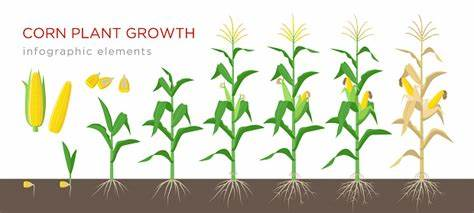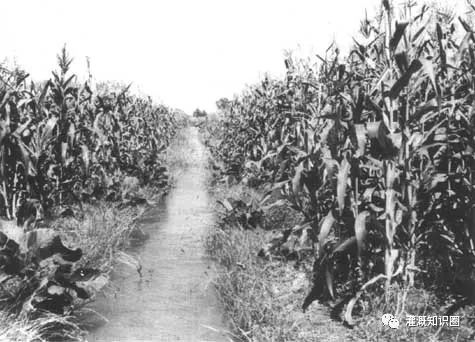在上一节中已经说明了如何估算标准草的每日需水量。在本节中,将解释如何使用标准草的每日需水量作为基础来估算其他作物的每日需水量。

很容易理解,成熟的玉米作物——叶面积大——每天将比成熟的萝卜或洋葱作物消耗更多的水;即两种作物在同一地区种植。
在确定作物类型对日常作物需水量的影响时,总是参考成熟的作物;植物已达到最大高度;它们以最佳方式覆盖地面;他们可能已经开始开花或开始结实。当作物完全生长时,它们的需水量最高。这是他们用水需求的所谓“高峰期”。
对于各种大田作物,可以确定与标准草相比它们需要多少水(图 7)。一些作物需要的水比草少,一些作物需要的水比草多,一些作物需要的水量或多或少与草相同。

图 7 与标准草相比,玉米需要多少水?
表 3 显示了五组作物。 第 1 列中的作物在高峰期比草需要的水少 30%。 第 2 列中的作物需要的水比草少 10%。 第 3 列中的作物需要与草等量的水。 第 4 列和第 5 列的作物在高峰期需要的水量分别比草多 10% 和 20%。
表 3 与标准草相比,各种大田作物高峰期作物需水量
|
Column 1 |
Column 2 |
Column 3 |
Column 4 |
Column 5 |
|
-30% |
-10% |
same as standard grass |
+ 10% |
+20% |
|
citrus |
cucumber |
carrots |
barley |
paddy rice |
|
olives |
radishes |
crucifers (cabbage, cauliflower, broccoli, etc.) |
beans |
sugarcane |
|
grapes |
squash |
lettuce |
maize |
banana |
|
melons |
flax |
nuts & fruit trees with cover crop |
||
|
onions |
small grains |
|||
|
peanuts |
cotton |
|||
|
peppers |
tomato |
|||
|
spinach |
eggplant |
|||
|
tea |
lentils |
|||
|
grass |
millet |
|||
|
cacao |
oats |
|||
|
coffee |
peas |
|||
|
clean cultivated nuts & fruit trees e.g. apples |
potatoes |
|||
|
safflower |
||||
|
sorghum |
||||
|
soybeans |
||||
|
sugarbeet |
||||
|
sunflower |
||||
|
tobacco |
||||
|
wheat |
例子
假设在某个区域,标准草作物每天需要 5.5 毫米的水。
然后,在同一地区,玉米需要多出 10% 的水。 5.5 毫米的百分之十 = 10/100 × 5.5 = 0.55 毫米。 因此,玉米每天需要 5.5 + 0.55 = 6.05 或 6.1 毫米的水。
问题
估算标准草需水量为 6.0 毫米/天的地区的柑橘、香蕉、洋葱、黄瓜、清洁栽培的苹果树和小米的需水量。
答案
|
Citrus: |
-30% (compared to grass); thus the water need of citrus is 6.0 - 30% = 6.0 -1.8 = 4.2 mm/day |
|
Bananas: |
+20%; thus the water need of bananas is 6.0 + 20% = 6.0 + 1.2 = 7.2 mm/day |
|
Onions: |
same as grass; thus the water need of onions is 6.0 mm/day |
|
Cucumber: |
-10%; thus the water need of onions is 6.0 - 10% =6.0-0.6 =5.4 mm/day |
|
Apples (clean): |
same as grass; thus the water need of clean cultivated apples is 6.0 mm/day |
|
If the apples have a cover crop in between the trees, the water need would be 20% higher than grass and thus: 6.0 + 20% = 6.0+1.2 = 7.2 mm/day. |
|
|
Millet: |
+10%; thus the water need of millet is 6.0 + 10% =6.0+0.6 = 6.6 mm/day |
















